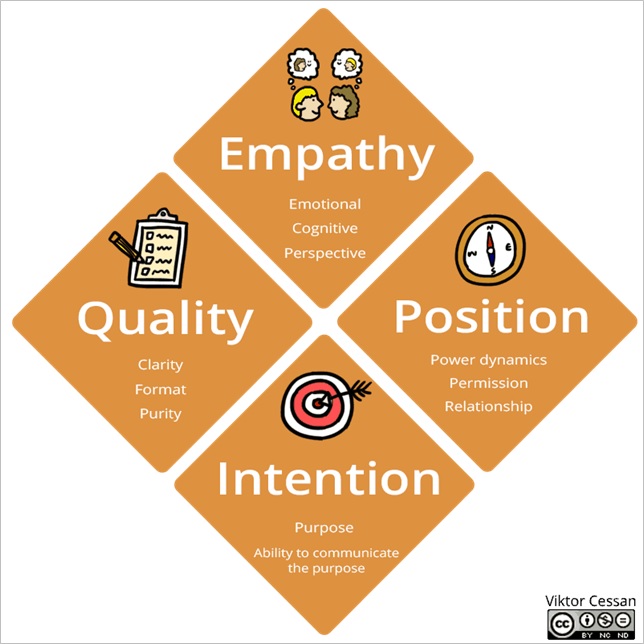Giving better feedback with the EPIQ Model
A workshop on feedback was on the agenda. The preparation seemed to be easy. I let the participants collect some topics, present the NVC Model and then we practise the implementation.
The NVC Model is perfect for dealing with disturbing patterns of behaviour, isn’t it? It is simple and clear, you can stick to it and as far as the wording is concerned, we will practise that:
- Talk about your observation: What did I perceive? What has happened?
- Talk about your feeling: How did it affect me? How did I feel?
- Talk about your need: Why did I feel like this? Why is this important to me?
- Make a request: That would be my wish. Therefore I ask you!
The communication is at eye level, I-messages instead of you-messages. A culture of change instead of a culture of mistakes, no putting down, no demands, but a wish, a request. Value-free communication, how a process can be improved. Perfect.
Nevertheless, something disturbed me, something was missing.
It is a communication of the self. I talk about my needs and tell the other person what kind of behaviour they can use to better meet my needs. But why should he or she do that? Or want to?
No one is in the world to be the way someone else wants him or her to be.
I can already hear this: “Yes, but if the performance is not right, if the behaviour disturbs the team and I just want to motivate a little … Somehow I have to be able to tell when one person is holding everyone up.” Right, but how do you do that so that the other person can accept it?
Feedback is not just feedback
During my search in the vastness of the net for another solution, I came across the workbook on the EPIQ Feedback Model by Swedish trainer and coach Victor Cessan and immediately became curious.
For Cessan, initially feedback is not just feedback. He starts by differentiating according to the intention of the feedback provider, his/her intention (the I of EPIQ). He distinguishes four themes:
- improving performance,
- motivation,
- improved self-perception or
- relationship improvement.
This made sense to me immediately, because these are completely different conversations, each with completely different basic conditions:
- I want performance to improve. With what justification, on the basis of what criteria, what arrangement or agreement? What was the specific assignment?
- I want to give an energy boost. Hmm. I want to motivate the person? Intrinsically? Challenging!
- I want to improve the self-perception. Self-perception? Does the person see himself as ‘wrong’? Who decides? What do the others say? What behavioural patterns are involved? Does he or she misbehave or misjudge his or her work performance?
- I want to improve my relationship with this person. What has gone wrong that I need formal feedback? Wouldn’t it be better to go for a beer or a coffee and talk to each other?
Talk to each other? That was what I was missing!
The NVC Model in action
Formally applied, the NVC Model means:
- Something about another person’s behaviour bothers me.
- I think about how to formulate it properly, in a way that meets the nonviolent communication demands.
- I grab the other person and give my presentation. (I may have asked beforehand if the person wants to hear this).
- Hopefully an insightful reaction from the other side, otherwise discussion with potential danger.
- Departure and hope for change.
Summarised: No discussion takes place. The approach does make me think about the wording. But it does not make me think about the situation in question and the people involved.
What Peter says about Paul says more about Peter than about Paul.
The EPIQ Model takes a completely different approach, because it prepares me for my conversation with a whole range of questions.
The EPIQ Feedback Model
Let’s take a detailed look at the EPIQ Feedback Model. Behind the letters of EPIQ are hidden – in a different order:
- Intention,
- Quality,
- Position,
- Empathy.
Let’s take a closer look at Victor Cessan’s usually very situational and systemic questions about the four areas. (Here the complete script of the Workbook can be downloaded.)
Intention
- What is your topic: performance improvement, motivation, improved self-perception or relationship improvement?
- Why do you want to give feedback?
- What do you hope to achieve with the feedback?
- If you have successfully presented your feedback and it has been accepted, what change should be visible? In whose name do you actually want to give the feedback?
Quality
- Replay the situation in your head on which you want to base your feedback. What actually happened there, what could have been observed by anyone else and what was your interpretation?
- If someone else had observed the situation, what would they have seen?
- Name two other possibilities to interpret the observed situation.
- Which view seems to fit best?
Position
- What is your relationship with the other person?
- Does the other person expect feedback from you and if so, what kind of feedback?
- How will you get permission to give feedback?
- Do you have an idea how you will start the feedback conversation?
- How could the feedback influence your inner balance?
Empathy
- Put yourself in the other person’s situation. What do you think went through His/her mind in that situation? What do you think was the other person’s goal?
- What would cause you to behave in exactly the same way?
- How do you think the other person felt in the situation?
- Think back to a time when you felt the same way. What was going through your mind at that time?
- How did you feel in that situation?
- On which level of empathy* (Emotional / Cognitive / Perspective) do you feel about this person?
- Which level(s) did you not consider?
* The three levels of empathy mean:
Emotional empathy: the ability to feel the same as other people (compassion); this is also called emotional sensitivity. (“I feel the same as you, I can empathise with that…”)
Cognitive empathy: The ability to understand not only other people’s feelings but also their thoughts and intentions and to draw correct conclusions about their behaviour. (“I think I know what made you do it…”)
Perspective/Social empathy: The ability to understand complex social situations (systems) with people from different cultures, character traits and value systems in order to be able to communicate constructively with them, to take their perspectives. (“I imagine this, in your situation, from your perspective…”)
The change of perspective in the EPIQ Feedback Model
Interesting questions, right? Yeah, sure, they take time. But it definitely pays off, if you calculate the benefit against it, the factual and humanly clearly better and longer lasting result.
For me, the decisive approach in the EPIQ Feedback Model is the change of perspective. I change from my perspective on things to the perspective of other people on the same things, including and first and foremost the perspective of the person I am talking about. The questions help me do this and prepare me very well for a conversation.
Anyone who has ever prepared themselves so intensively for a difficult, conflict-ridden conversation knows that in the end everything may look very different and you are relieved that you did not have the original conversation.
First exploring the other side’s perspective, rethinking one’s own position and then discussing a solution together means in detail:
- To analyse the possible view of the other side with the help of the list of questions, to form hypotheses about the background and sensitivities, and in doing so to rethink one’s own position.
- To have an understanding conversation, i.e. to listen in order to get to know the other side’s point of view, to check one’s own hypotheses and to further rethink one’s own position.
- To discuss together a solution with which both sides can live, whatever the solution may be.
Before you speak, let your words go through three gates.
At the first gate ask: “Are they true?”
At the second gate ask: “Are they necessary?”
At the third gate ask: “Are they friendly?”
[Sokrates]
Quintessence
The analysis of a critical situation with the EPIQ Feedback Model inevitably leads to the realisation that it is not our job to personally evaluate the actions of other people. For our four feedback topics from the beginning this means:
- If there is a factual agreement, one can talk about the fulfilment of the task. If there is no basis for this, then something suitable must first be agreed.
- In order to motivate, it is important to first find the demotivating factors and then create an appropriate framework for development.
- When it comes to behaviour patterns, the question is whether the person wants to be coached or whether there are rules for dealing with each other in the team. In any case, nothing works without appreciation and empathy.
- In order to improve a relationship, it is best to start at the bottom and look for the underlying causes of the disgruntlement and your own part in it.
Asking is always better than telling. A good question does not confront but opens. At the end of such conversations it makes sense to check together the rules of how we deal with each other and optimise them if necessary.
And I’m sorry that I don’t think much of “telling someone their opinion”. It can be very liberating, but it does not help. Rather the opposite, it leads to a toxic atmosphere.
Notes:
Conrad Giller has published more posts in the t2informatik Blog:

Conrad Giller
Conrad Giller has been working for about 30 years as a trainer, coach and consultant for almost all challenges of oral communication: conflict, team, leadership, storytelling, presenting, moderating, media, etc. He is happy to pass on his experience online and offline in workshops.



